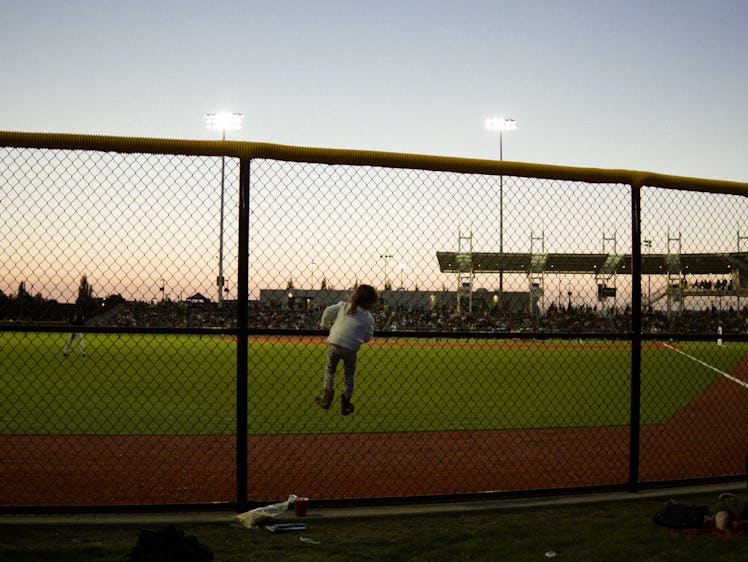A Guy Who’s Caught 8,000 Balls At MLB Games On Making Sure Your Kid Gets A Souvenir
It's a long fly ball to center ...

For more advice on fun stuff to do with your kids, from ridiculously overqualified experts, check out the rest of our 940 Weekends.
You’ve tried and failed for most of your baseball watching career, and now you’re going to subject your kid to it. Yes, getting in position to snag a foul ball in a Major League stadium is the second goal of any ballpark outing (the first is beer) and today is going to be that day you become the Most Valuable Dad. Zack Hample is one of the most prodigious ball hawkers in the world. He’s traveled to 51 ballparks and nabbed more than 8,000 foul balls, home runs, and toss-ups — including Alex Rodriguez’s 3,000th hit.
Hample has also written 3 books on how to not only flash some fan leather, but have the best time possible watching a game. Here are his tips on how to come home with a priceless souvenir. Tip number one: Make sure he’s not at the same ballpark as you.
Get There Early And Hit The Outfield
Every Major League stadium opens at least 90 minutes before the first pitch is thrown, or up to 3 hours for season ticket holders. This is when batting practice takes place — aka ball hawker’s paradise. “I recommend getting there when the gates open because security is not as strict,” says Hample. That means that no matter where your seats are, you can roam freely toward the outfield.
During BP, coaches toss easy pitches so batters can warm up. Many of those meatballs wind up soaring into the outfield stands and are easy pickings in uncrowded stands. So go early and wear a glove. “It’s the most fun time of the day,” says Hample. Not only do you have the best chance to get a ball, but you can chat up players and get some autographs. “If you’re trying to get a kid interested in baseball, or if they’re on the fence, this can be the thing that converts them,” he says.
Catch A Home Run Or A Foul Ball
If you have a child over 10, toss ups aren’t nearly as much fun as catching a ball. To do this during batting practice, look for open areas in the stands several rows back. “It’s all about making sure I have open space to the left and right. Lateral mobility is key,” says Hample. Watch as the pitches are thrown. As soon as the bat makes contact with the ball, start moving towards where it might land. “A lot of people stand there and stare up, watching this majestic flying ball,” he says. Don’t be one of them.
During the game, foul balls are more common and usually land to either side of home plate, beyond any protective netting, and sometimes in the first rows of the second deck. Choose seats in those areas to maximize foul ball-catching — just keep your head up because sometimes those balls are actually broken bats.
Know The Players
Before the game, print out the both teams’ rosters from their websites. “That can help you identify anyone on the field,” says Hample. It’s something useful to have when asking for toss-ups, but you can also get all Moneyball with it and predict where a batter’s hit will land.
Right-handed batters usually hit to left field, and vice versa for lefties. (Watch out for pull-hitters.) Stack the odds by choosing the outfield stands most likely to receive home runs during batting practice. If more balls seem to be heading to the other stand, “take a 2-minute jog around the outfield. It’s a great way to be interactive with your kid and have your own game within the game,” he says.
Keep Your Eye On The Ball
It can be easy to miss any of the hundreds of pitches thrown before or during the game, but try not to. “Every injury I’ve seen is when people are not looking,” says Hample. “You could be 400 feet from home plate, and it may not occur to you that balls can land where you are, but they can. Believe me.” Foul balls can unexpectedly jump into the stands behind the dugouts, so keep that in mind when choosing seats, especially with babies. (They’re terrible at the hot corner).
Get a Toss-Up During The Game
Every half-inning during the game, the ball used for the third out often gets tossed to the crowd. Be behind the dugout when the player with the ball trots over and say, “How about a ball for my little guy?”
If a ball is hit down the foul line, usually a ball boy or girl will pick it up and give it to the crowd. “Don’t wait for them to scoop it up,” says Hampe. When the ball is hit, start going to where it’s picked up. “Walk down the stairs so by the time they’re there you can ask for the ball. It’s about anticipating.” Also, learn that person’s name.
This article was originally published on